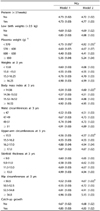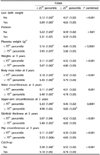1. Ross R. The pathogenesis of atherosclerosis: a perspective for the 1990s. Nature. 1993; 362:801–809.

2. Burke V. Obesity in childhood and cardiovascular risk. Clin Exp Pharmacol Physiol. 2006; 33:831–837.

3. Berenson GS, Wattigney WA, Tracy RE, Newman WP 3rd, Srinivasan SR, Webber LS, Dalferes ER Jr, Strong JP. Atherosclerosis of the aorta and coronary arteries and cardiovascular risk factors in persons aged 6 to 30 years and studied at necropsy (The Bogalusa Heart Study). Am J Cardiol. 1992; 70:851–858.

4. Barker DJ, Osmond C, Forsén TJ, Kajantie E, Eriksson JG. Trajectories of growth among children who have coronary events as adults. N Engl J Med. 2005; 353:1802–1809.

5. Huxley RR, Shiell AW, Law CM. The role of size at birth and postnatal catch-up growth in determining systolic blood pressure: a systematic review of the literature. J Hypertens. 2000; 18:815–831.

6. American Academy of Pediatrics. Cardiovascular risk reduction in high-risk pediatric populations. Pediatrics. 2007; 119:618–621.
7. Finkelstein JD. Methionine metabolism in mammals. J Nutr Biochem. 1990; 1:228–237.

8. Groner JA, Joshi M, Bauer JA. Pediatric precursors of adult cardiovascular disease: noninvasive assessment of early vascular changes in children and adolescents. Pediatrics. 2006; 118:1683–1691.

9. Jakubowski H. Pathophysiological consequences of homocysteine excess. J Nutr. 2006; 136:1741S–1749S.

10. Haim M, Tanne D, Goldbourt U, Doolman R, Boyko V, Brunner D, Sela BA, Behar S. Serum homocysteine and long-term risk of myocardial infarction and sudden death in patients with coronary heart disease. Cardiology. 2007; 107:52–56.

11. Tonstad S, Refsum H, Sivertsen M, Christophersen B, Ose L, Ueland PM. Relation of total homocysteine and lipid levels in children to premature cardiovascular death in male relatives. Pediatr Res. 1996; 40:47–52.

12. Vilaseca MA, Moyano D, Ferrer I, Artuch R. Total homocysteine in pediatric patients. Clin Chem. 1997; 43:690–692.

13. Shen MH, Chu NF, Wu DM, Chang JB. Plasma homocyst(e)ine, folate and vitamin B(12) levels among school children in Taiwan: The Taipei Children Heart Study. Clin Biochem. 2002; 35:495–498.

14. Leal AA, Palmeira AC, Castro GM, Simões MO, Ramos AT, Medeiros CC. Homocysteine: cardiovascular risk factor in children and adolescents? Rev Assoc Med Bras. 2013; 59:622–628.

15. Min JW, Kong KA, Park BH, Hong JH, Park EA, Cho SJ, Ha EH, Park H. Effect of postnatal catch-up growth on blood pressure in children at 3 years of age. J Hum Hypertens. 2007; 21:868–874.

17. Araki A, Sako Y. Determination of free and total homocysteine in human plasma by high-performance liquid chromatography with fluorescence detection. J Chromatogr B Biomed Sci Appl. 1987; 422:43–52.

18. World Health Organization (CH). Serum and Red Blood Cell Folate Concentrations for Assessing Folate Status in Populations. Vitamin and Mineral Nutrition Information System. Geneva: World Health Organization;2012.
19. Fukagawa NK, Martin JM, Wurthmann A, Prue AH, Ebenstein D, O'Rourke B. Sex-related differences in methionine metabolism and plasma homocysteine concentrations. Am J Clin Nutr. 2000; 72:22–29.

20. Klerk M, Verhoef P, Clarke R, Blom HJ, Kok FJ, Schouten EG; MTHFR Studies Collaboration Group. MTHFR 677C-->T polymorphism and risk of coronary heart disease: a meta-analysis. JAMA. 2002; 288:2023–2031.

21. Humphrey LL, Fu R, Rogers K, Freeman M, Helfand M. Homocysteine level and coronary heart disease incidence: a systematic review and meta-analysis. Mayo Clin Proc. 2008; 83:1203–1212.

22. Barker DJ, Gluckman PD, Godfrey KM, Harding JE, Owens JA, Robinson JS. Fetal nutrition and cardiovascular disease in adult life. Lancet. 1993; 341:938–941.

23. Leeson CP, Whincup PH, Cook DG, Donald AE, Papacosta O, Lucas A, Deanfield JE. Flow-mediated dilation in 9- to 11-year-old children: the influence of intrauterine and childhood factors. Circulation. 1997; 96:2233–2238.
24. Bergen NE, Jaddoe VW, Timmermans S, Hofman A, Lindemans J, Russcher H, Raat H, Steegers-Theunissen RP, Steegers EA. Homocysteine and folate concentrations in early pregnancy and the risk of adverse pregnancy outcomes: the Generation R Study. BJOG. 2012; 119:739–751.

25. Ouyang F, Parker M, Cerda S, Pearson C, Fu L, Gillman MW, Zuckerman B, Wang X. Placental weight mediates the effects of prenatal factors on fetal growth: the extent differs by preterm status. Obesity (Silver Spring). 2013; 21:609–620.

26. Thornburg KL, O'Tierney PF, Louey S. Review: the placenta is a programming agent for cardiovascular disease. Placenta. 2010; 31:Suppl. S54–S59.

27. Papandreou D, Mavromichalis I, Makedou A, Rousso I, Arvanitidou M. Total serum homocysteine, folate and vitamin B12 in a Greek school age population. Clin Nutr. 2006; 25:797–802.

28. Wald DS, Law M, Morris JK. Homocysteine and cardiovascular disease: evidence on causality from a meta-analysis. BMJ. 2002; 325:1202–1206.

29. Osganian SK, Stampfer MJ, Spiegelman D, Rimm E, Cutler JA, Feldman HA, Montgomery DH, Webber LS, Lytle LA, Bausserman L, Nader PR. Distribution of and factors associated with serum homocysteine levels in children: Child and Adolescent Trial for Cardiovascular Health. JAMA. 1999; 281:1189–1196.

30. Wald DS, Wald NJ, Morris JK, Law M. Folic acid, homocysteine, and cardiovascular disease: judging causality in the face of inconclusive trial evidence. BMJ. 2006; 333:1114–1117.

31. Lonn E, Yusuf S, Arnold MJ, Sheridan P, Pogue J, Micks M, McQueen MJ, Probstfield J, Fodor G, Held C, Genest J. Heart Outcomes Prevention Evaluation (HOPE) 2 Investigators. Homocysteine lowering with folic acid and B vitamins in vascular disease. N Engl J Med. 2006; 354:1567–1577.

32. Berdanier CD, Feldman EB, Dwyer J. Ch10. Potential benefits for the use of vitamin and mineral supplements. In : Cotter R, Moreines J, Ellenbogen L, editors. Handbook of Nutrition and Food. Second Edition. Boca Raton (FL): CRC Press;2007. p. 200.
33. Delvin EE, Rozen R, Merouani A, Genest J Jr, Lambert M. Influence of methylenetetrahydrofolate reductase genotype, age, vitamin B-12, and folate status on plasma homocysteine in children. Am J Clin Nutr. 2000; 72:1469–1473.

34. Hong J, Lee HA, Park EA, Kim YJ, Lee H, Park BH, Ha EH, Kong KA, Chang N, Park H. Association of mid-pregnancy antioxidative vitamin and oxidative stress levels with infant growth during the first 3 years of life. Food Nutr Res. 2014; 58:20207.








 PDF
PDF ePub
ePub Citation
Citation Print
Print


 XML Download
XML Download